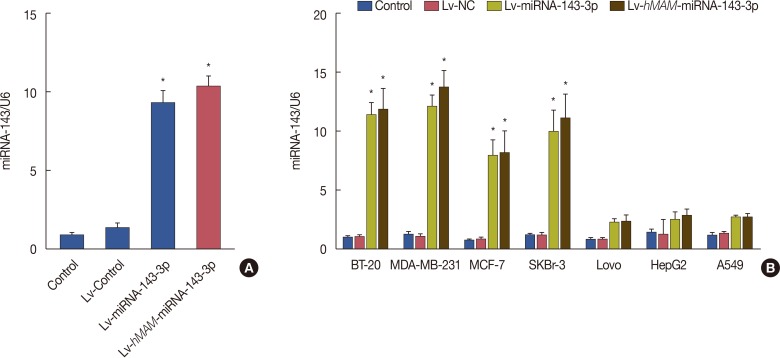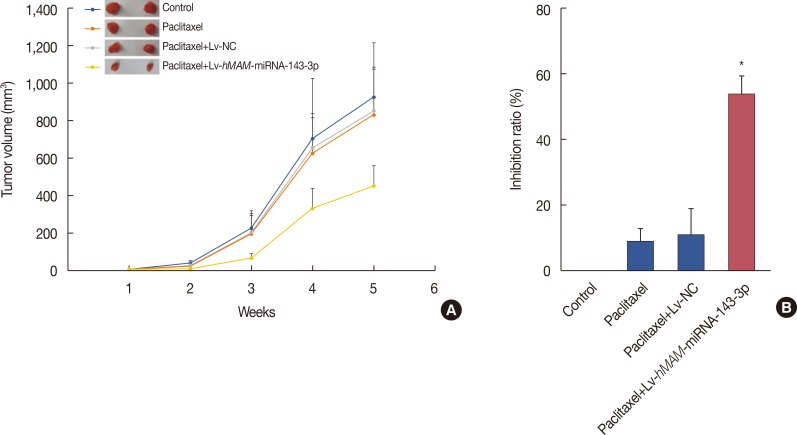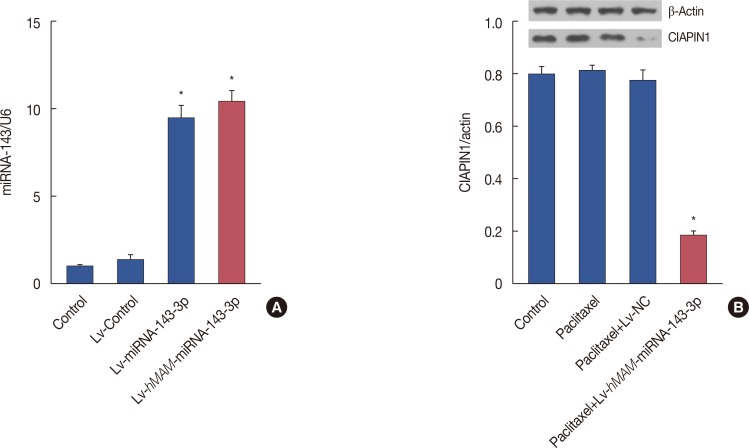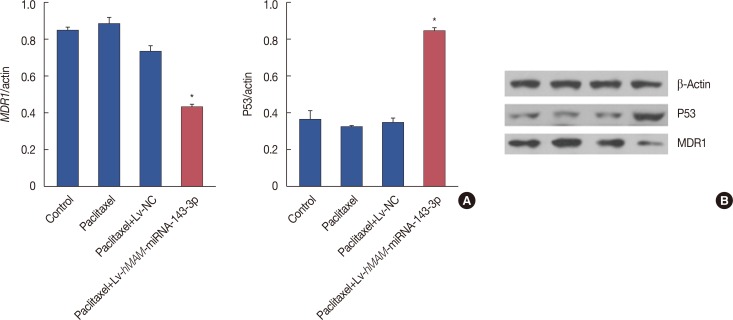INTRODUCTION
METHODS
Cell culture
Construction of hsa-miRNA-143-3p expression vector containing breast cancer-specific hMAM promoter and recombinant virus
Detecting expression specificity and efficiency of the hMAM promoter
Experimental subjects and group information
Gene interference and drug administration
RNA extraction and real-time polymerase chain reaction
Western blot analysis
Ethical approval
RESULTS
High transcription activity and specificity of the hMAM promoter in TNBC
 | Figure 1Detection of expression efficiency and specificity of hsa-miRNA-143-3p under control of the hMAM promoter. (A) The recombinant viruses were Lv-NC, Lv-miRNA-143-3p (containing the CMV promoter), and Lv-hMAM-miRNA-143-3p (containing the hMAM promoter). For 72 hours after infection of MDA-MB-231 cells, the relative content of hsa-miRNA-143-3p is shown, with U6 level as a reference. Relative hsa-miRNA-143-3p values were normalized to that of the control group as a reference for data comparison. (B) MDA-MB-231, BT-20, MCF7, SKBr-3, Lovo, HepG2, and A549 cells were infected with Lv-NC, Lv-miRNA-143-3p, or Lv-hMAM-miRNA-143-3p, respectively. After 72 hours, the relative content of hsa-miRNA-143-3p was determined, with U6 level as a reference. Relative hsa-miRNA-143-3p values were normalized to that of the control group as a reference for data comparison. The experimental design was repeated 3 times. Data are represented as mean±standard error of the mean.Lv-hMAM-miRNA-143-3p=lentiviral-expressed vector human mammaglobin (hMAM) miRNA-143-3p; Lv-NC=lentiviral-expressed vector no-antisense oligomers control group; CMV=cytomegalovirus. *p=0.001 vs. control group.
|
Hsa-miRNA-143-3p enhances sensitivity of TNBC to paclitaxel
 | Figure 2Overexpression of hsa-miRNA-143-3p and the sensitivity of triple-negative breast cancer to paclitaxel. (A) The tumor volume growth rate and tumor size in the Lv-hMAM-miRNA-143-3p+paclitaxel group were significantly reduced compared with those in the Lv-NC+paclitaxel group, paclitaxel group, and physiological saline control group. (B) Upregulating the expression of hsa-miRNA-143-3p prominently increased the tumor growth inhibition ratio in the Lv-hMAM-miRNA-143-3p+paclitaxel group compared to that of the other groups. The experimental design was repeated 3 times. Data are represented as mean±standard error of the mean.Lv-hMAM-miRNA-143-3p=lentiviral-expressed vector human mammaglobin (hMAM) miRNA-143-3p; Lv-NC=lentiviral-expressed vector no-antisense oligomers control group. *p=0.001.
|
Hsa-miRNA-143-3p interfered the expression of CIAPIN1 protein
 | Figure 3Activation of multidrug resistance by cytokine-induced apoptosis inhibitor 1 (CIAPIN1) targeting to hsa-miRNA-143-3p in triple-negative breast cancer (TNBC). (A) Transcript level of hsa-miRNA-143-3p notably increased upon infection with hsa-miRNA-143-3p compared with the level in other groups as determined by real-time polymerase chain reaction. (B) Western blot showing that CIAPIN1 protein levels decreased in TNBC tissue expressing hsa-miRNA-143-3p. The experimental design was repeated 3 times. Data are represented as mean±standard error of the mean.β-actin=reference protein; Lv-hMAM-miRNA-143-3p=lentiviral-expressed vector hMAM miRNA-143-3p; Lv-NC=lentiviral-expressed vector no-antisense oligomers control group. *p=0.001.
|
Quantitative analysis to related functional proteins
 | Figure 4Hsa-miRNA-143-3p expression and other drug resistance-relating proteins. Western blot showing that P53 protein levels increased while multidrug resistance gene 1 (MDR1) levels decreased in the Lv-hMAM-miRNA-143-3p+paclitaxel group compared to levels in other groups. The experimental design was repeated 3 times. Data are represented as mean±standard error of the mean. (A) Western blot showing that P53 protein levels increased while MDR1 levels decreased in the Lv-hMAM-miRNA-143-3p+paclitaxel group compared to levels in other groups. (B) Electrophoretic band of the P53 and MDR1 expression level as described above.β-actin=reference protein; Lv-hMAM-miRNA-143-3p=lentiviral-expressed vector hMAM miRNA-143-3p; Lv-NC=lentiviral-expressed vector no-antisense oligomers control group. *p=0.001.
|




 PDF
PDF ePub
ePub Citation
Citation Print
Print


 XML Download
XML Download